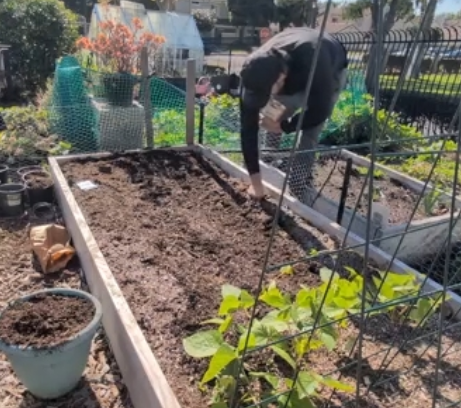Are you ready to transform your gardening experience and unlock bountiful harvests? Sheet mulching in raised beds offers a powerful method to create fertile, weed-free growing spaces. By strategically layering organic materials, you'll build rich soil teeming with nutrients. This article will guide you through constructing sturdy raised beds, implementing effective sheet mulching techniques, and optimizing your garden layout.
You'll learn how to incorporate trellises for vertical growth, utilize companion planting to deter pests naturally, and properly sow seeds for maximum germination. Get ready to elevate your gardening skills and create a thriving ecosystem in your own backyard. Stay tuned for future insights on sustainable growing methods like the Three Sisters technique.
Preparing Your Raised Bed Garden for Sheet Mulching
Laying the Foundation
Begin by clearing your designated garden area of existing weeds. Cut them down to ground level, ensuring a clean slate for your raised bed. Next, lay down a layer of cardboard directly on the soil. This crucial step acts as a natural weed suppressor, preventing unwanted growth from below while allowing beneficial organisms to thrive.
Building Nutrient-Rich Layers
With your foundation set, it's time to create a nutrient-dense environment for your plants. Start by sprinkling a layer of blood meal over the cardboard. This organic fertilizer is rich in nitrogen, essential for leafy green growth. Follow with a layer of wood chips, then alternate between blood meal and wood chips to build up your bed. Look to add around 6 inches of wood chips total and do not forget to water your bed throughout this process every couple of inches.
Adding the Growing Medium
Now, prepare a mixture of organic matter, soil, and well-composted chicken manure. This blend provides a diverse range of nutrients and promotes healthy soil structure. Spread this mixture evenly over your layered base. Top it off with high-quality topsoil, creating the perfect medium for your plants to root and flourish.
Protecting Your Garden
Finally, add a thin layer of pine shavings over the topsoil. This acts as a natural mulch, helping to retain moisture and further suppress weed growth. Your raised bed is now primed for planting, offering the ideal environment for bountiful harvests. This protective covering will gradually break down, continually feeding your soil ecosystem.
Constructing Sturdy Raised Beds for Bountiful Harvests
Choosing the Right Materials
When building raised beds, selecting durable materials is crucial for long-lasting success. Opt for 2x12x10 fir wood planks, known for their resilience and natural resistance to decay. These robust boards provide ample depth for root growth and soil retention, ensuring your garden thrives for years to come.
Assembly and Placement
Begin by selecting a level area with adequate sunlight for your raised beds. Arrange the fir planks to form rectangular frames, securing the corners with galvanized screws or brackets for added stability. Consider adding a layer of hardware cloth to the bottom of the bed to deter burrowing pests.
Companion Planting and Trellis Structures for Thriving Plants
Maximizing Vertical Space with Trellis A-Frames
To optimize your raised bed garden, consider installing trellis A-frames for climbing plants like tomatoes and cucumbers. These structures not only save space but also improve air circulation, sunlight exposure, and reduce fungal disease. Construct sturdy A-frames using bamboo poles or wooden stakes or buy metal frames online, securing them firmly in the soil. Position these structures on the north side of your beds to prevent shading other crops. Train your vines to climb by gently tying them to the trellis as they grow.
Strategic Companion Planting for Pest Control
Harness the power of companion planting to naturally deter pests and enhance your garden's health. Intersperse marigolds and basil throughout your raised beds to repel harmful insects. Marigolds emit a scent that deters aphids and nematodes, while basil helps keep mosquitoes and flies at bay. These aromatic plants not only protect your vegetables but also add beauty and flavor to your garden. This organic approach reduces the need for chemical pesticides, fostering a healthier environment for your crops.
Sowing Seeds for a Sustainable Food Oasis
Proper Seed Sowing Techniques
For successful direct sowing, prepare your soil by raking it smooth and creating shallow furrows. Plant seeds at the depth recommended on the packet, typically 2-3 times their diameter. Space seeds according to their mature size, allowing room for growth. You can plant closer together and just make sure to harvest throughout the season before full mature growth. After sowing, gently water the area and keep the soil consistently moist until germination occurs. Consider using row covers to protect young seedlings from pests and harsh weather conditions.
By implementing these companion planting strategies, trellis structures, and proper sowing techniques, you'll create a thriving, productive raised bed garden that maximizes space and minimizes pest issues.
Direct Sowing Techniques
When sowing seeds directly into your prepared soil, follow these best practices:
- Create shallow furrows appropriate for each seed type
- Space seeds according to package instructions
- Gently cover with soil and water thoroughly
- Maintain consistent moisture until germination
Remember to thin seedlings as they grow to ensure proper spacing and nutrient availability.
Conclusion
By implementing raised bed sheet mulching in your garden, you're setting the stage for bountiful harvests and sustainable food production. This method maximizes soil health, suppresses weeds, and creates an ideal growing environment for your plants. Remember to construct sturdy raised beds, incorporate companion planting strategies, and properly sow your seeds for optimal results.
As you embark on your gardening journey, continue to experiment with techniques like the Three Sisters method to further enhance your yields. Stay tuned for our upcoming article on this ancient sustainable planting technique that combines corn, beans, and squash. .
Subscribe to our blog for more expert gardening tips and tricks to help you cultivate a thriving, productive and eco-friendly garden all season long.
Photos of the Process


Creating the Raised Bed Frames





-transparent.svg)


